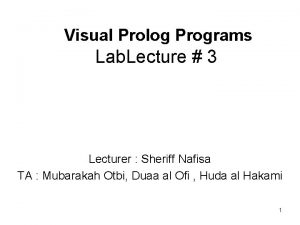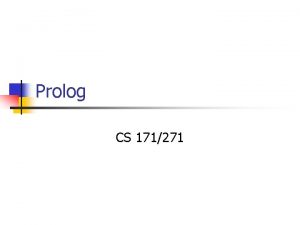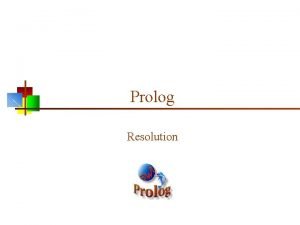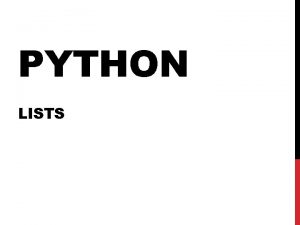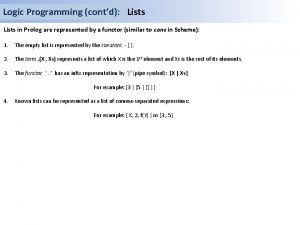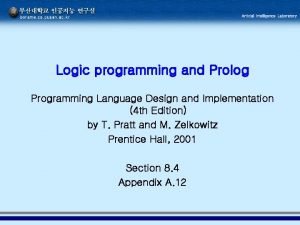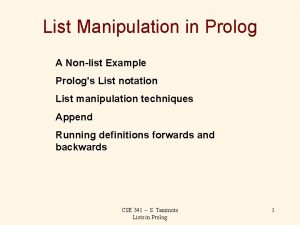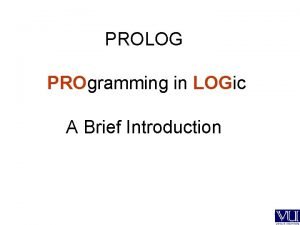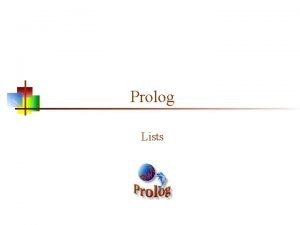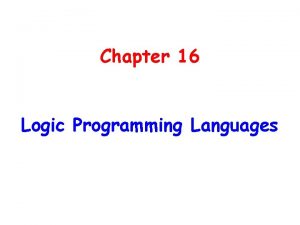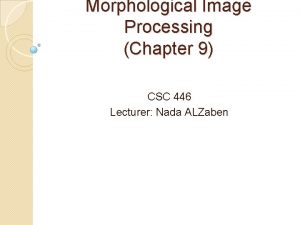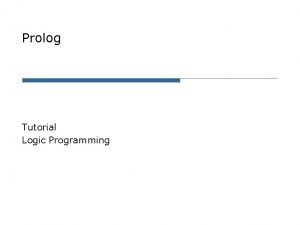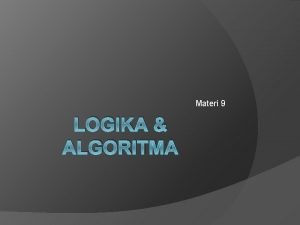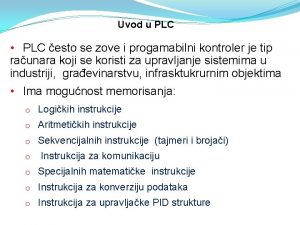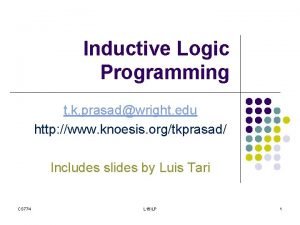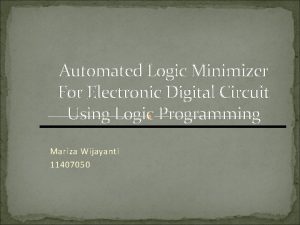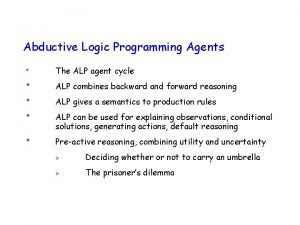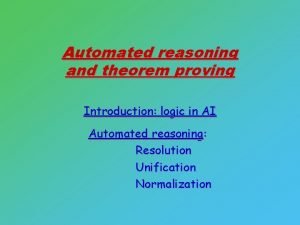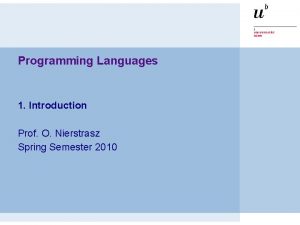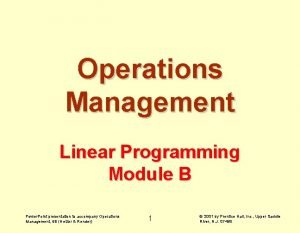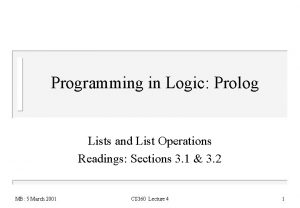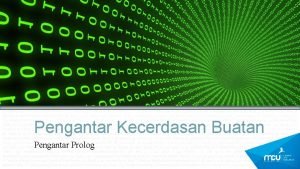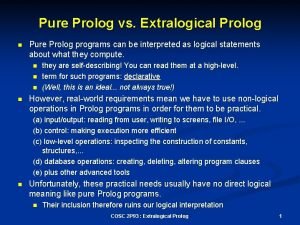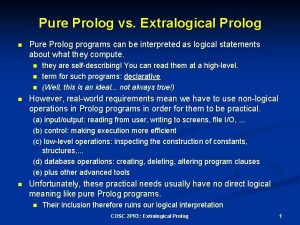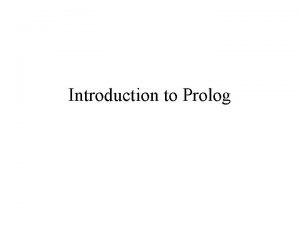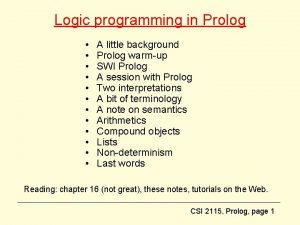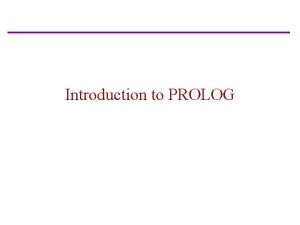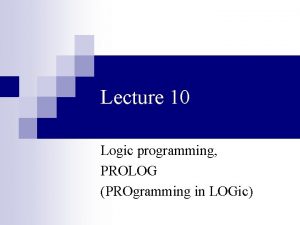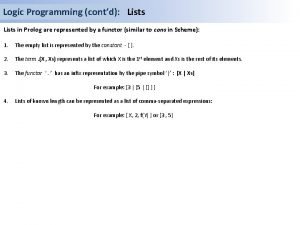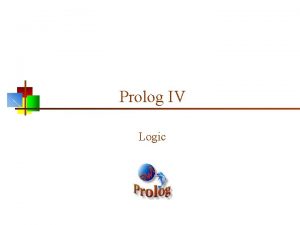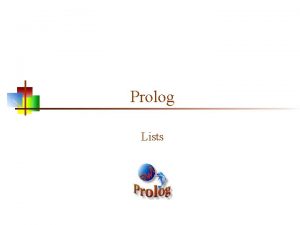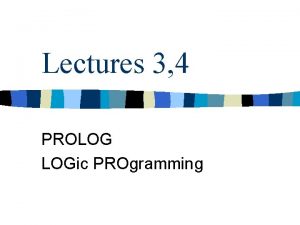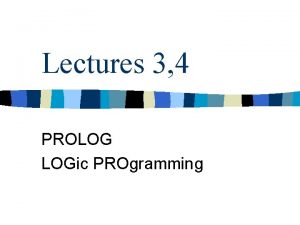Programming in Logic Prolog Lists and List Operations





![Lists n [3, x | T] matches : – – – n [3, x], Lists n [3, x | T] matches : – – – n [3, x],](https://slidetodoc.com/presentation_image_h2/3d878e7cfff3742e1197ead65e1092c5/image-6.jpg)
![Definition of List n List definition: – – list([ ]). list([I|L 1]) : - Definition of List n List definition: – – list([ ]). list([I|L 1]) : -](https://slidetodoc.com/presentation_image_h2/3d878e7cfff3742e1197ead65e1092c5/image-7.jpg)




![List Membership KB: 1. member(I, [ I | _ ]). 2. member(I, [_| T] List Membership KB: 1. member(I, [ I | _ ]). 2. member(I, [_| T]](https://slidetodoc.com/presentation_image_h2/3d878e7cfff3742e1197ead65e1092c5/image-12.jpg)
![List Membership KB: 1. member(I, [ I | _ ]). 2. member(I, [_| T] List Membership KB: 1. member(I, [ I | _ ]). 2. member(I, [_| T]](https://slidetodoc.com/presentation_image_h2/3d878e7cfff3742e1197ead65e1092c5/image-13.jpg)
![List Membership KB: 1. member(I, [ I | _ ]). 2. member(I, [_| T] List Membership KB: 1. member(I, [ I | _ ]). 2. member(I, [_| T]](https://slidetodoc.com/presentation_image_h2/3d878e7cfff3742e1197ead65e1092c5/image-14.jpg)

![List Concatenation n List defn base case is [ ], should this be our List Concatenation n List defn base case is [ ], should this be our](https://slidetodoc.com/presentation_image_h2/3d878e7cfff3742e1197ead65e1092c5/image-16.jpg)






![List Operations n Deletes item from list: – – n del(Item, [Item| Tail], Tail). List Operations n Deletes item from list: – – n del(Item, [Item| Tail], Tail).](https://slidetodoc.com/presentation_image_h2/3d878e7cfff3742e1197ead65e1092c5/image-23.jpg)




![Permutation Defined permutation([ ], [ ]). n permutation([X | L 1], Perm) : permutation(L Permutation Defined permutation([ ], [ ]). n permutation([X | L 1], Perm) : permutation(L](https://slidetodoc.com/presentation_image_h2/3d878e7cfff3742e1197ead65e1092c5/image-28.jpg)



- Slides: 31

Programming in Logic: Prolog Lists and List Operations Readings: Sections 3. 1 & 3. 2 MB: 5 March 2001 CS 360 Lecture 4 1

Prolog Lists n The elements of a list can be anything including other lists. n Remember that atoms could be made from a sequence of special characters, the empty list is the special atom “[ ]”. MB: 5 March 2001 CS 360 Lecture 4 2

Lists n A non-empty list always contains two things, a head and the tail. It is a structured data object. The functor name is “. ” and its arity is 2. n The list consisting of the item “ 3” is: . (3, [ ]) MB: 5 March 2001 CS 360 Lecture 4 3

Lists cont’d The list consisting of the two items “ 3” and “x” is: . (3, . (x, [ ])) n Lists are one of the most pervasive data structures in Prolog, so there is a special notation for them: [3, x] n MB: 5 March 2001 CS 360 Lecture 4 4

Lists cont’d Often want to describe beginning of list without specifying the rest of it. For example, . (3, . (x, T)) describes a list whose first two items are 3 and x, and whose remaining items could be anything (including empty). n Prolog provides a special notation for doing this, “|”, e. g. , [3, x |T] n MB: 5 March 2001 CS 360 Lecture 4 5
![Lists n 3 x T matches n 3 x Lists n [3, x | T] matches : – – – n [3, x],](https://slidetodoc.com/presentation_image_h2/3d878e7cfff3742e1197ead65e1092c5/image-6.jpg)
Lists n [3, x | T] matches : – – – n [3, x], [3, x, y(5)], and [3, x, 56, U, name(mike, barley)] (among others) with T = – – – [ ], [y(5)], and [56, U, name(mike, barley)] MB: 5 March 2001 CS 360 Lecture 4 6
![Definition of List n List definition list listIL 1 Definition of List n List definition: – – list([ ]). list([I|L 1]) : -](https://slidetodoc.com/presentation_image_h2/3d878e7cfff3742e1197ead65e1092c5/image-7.jpg)
Definition of List n List definition: – – list([ ]). list([I|L 1]) : - list(L 1). MB: 5 March 2001 CS 360 Lecture 4 7

List Operations n Since lists are an inductively defined data structure, expect operations to be inductively defined. n One common list operation is checking whether something is a member of the list. – member(Item, List) MB: 5 March 2001 CS 360 Lecture 4 8

List Membership n If defining list membership inductively, need to figure out base case for list variable. n Base case for defn of list is [ ], but not appropriate for base case of membership. Why? n Need to look elsewhere. What’s the simplest case for deciding membership? MB: 5 March 2001 CS 360 Lecture 4 9

List Membership n It’s the first item in the list. Maybe this can be our base case. – n member(Item, List) : - List = [Item | _ ]. Prolog is pattern-directed, i. e. , does pattern matching, can use this to simplify base case: – member( I, [ I | _ ]). MB: 5 March 2001 CS 360 Lecture 4 10

List Membership n What if item is not the first one in list, then what? Then need to check if it’s in the tail. – n member(I, [ _ | T ]) : - member(I, T). Don’t we have to check for empty list case? – No, because if we hit the empty list, then I is not in the list, so we should fail. MB: 5 March 2001 CS 360 Lecture 4 11
![List Membership KB 1 memberI I 2 memberI T List Membership KB: 1. member(I, [ I | _ ]). 2. member(I, [_| T]](https://slidetodoc.com/presentation_image_h2/3d878e7cfff3742e1197ead65e1092c5/image-12.jpg)
List Membership KB: 1. member(I, [ I | _ ]). 2. member(I, [_| T] : - member(I, T). Query: member(x, [ ]). Response: no MB: 5 March 2001 Execution Trace: [member(x, [ ])] CS 360 Lecture 4 12
![List Membership KB 1 memberI I 2 memberI T List Membership KB: 1. member(I, [ I | _ ]). 2. member(I, [_| T]](https://slidetodoc.com/presentation_image_h2/3d878e7cfff3742e1197ead65e1092c5/image-13.jpg)
List Membership KB: 1. member(I, [ I | _ ]). 2. member(I, [_| T] : - member(I, T). Partial Execution Trace: [member(x, [ w, x ])] 2. I=x, T=[x] Query: member(x, [ w, x]). [member(x, [x])] Response: MB: 5 March 2001 continue trace CS 360 Lecture 4 13
![List Membership KB 1 memberI I 2 memberI T List Membership KB: 1. member(I, [ I | _ ]). 2. member(I, [_| T]](https://slidetodoc.com/presentation_image_h2/3d878e7cfff3742e1197ead65e1092c5/image-14.jpg)
List Membership KB: 1. member(I, [ I | _ ]). 2. member(I, [_| T] : - member(I, T). Partial Execution Trace: [member(X, [ w, x ])] 1. X=I, I=w [] Query: member(X, [ w, x]). continue trace Response: X=w ? ; MB: 5 March 2001 CS 360 Lecture 4 14

List Concatenation n Define relation conc(L 1, L 2, L 3) where L 3 is the result of concatenating L 1 onto front of L 2. n What is the base case? n Go back to defn of list, what is base case? MB: 5 March 2001 CS 360 Lecture 4 15
![List Concatenation n List defn base case is should this be our List Concatenation n List defn base case is [ ], should this be our](https://slidetodoc.com/presentation_image_h2/3d878e7cfff3742e1197ead65e1092c5/image-16.jpg)
List Concatenation n List defn base case is [ ], should this be our base case for defining concatenation? n conc([ ], ? ) - what is the result of concatenating [ ] onto anything? Are there special cases? n conc([ ], L 2). MB: 5 March 2001 CS 360 Lecture 4 16

List Concatenation What should the inductive step be? n What was the inductive step for list defn? n What should the head look like? n conc([ I | L 1], L 2, [ I | L 3]) n What’s the relation between L 1, L 2, and L 3? n conc(L 1, L 2, L 3) n MB: 5 March 2001 CS 360 Lecture 4 17

List Concatenation n Full definition: – – n Try doing an execution trace for the query: – n conc([ ], L, L). conc([ I | L 1], L 2, [I|L 3]) : - conc(L 1, L 2, L 3). conc(L 1, L 2, [1, 2, 3]). What are the bindings for L 1 and L 2 if keep asking for alternatives? MB: 5 March 2001 CS 360 Lecture 4 18

Multi-Way Uses of Relations We have seen that one nice feature of logic programming is its absence of control. n This means we can define one central relation and use it in a number of different ways. What it means depends upon which arguments are variables, partially variablized and/or constants. n conc/3 is an example of such a central relation. n MB: 5 March 2001 CS 360 Lecture 4 19

Some Uses of Concatenation n member(I, L) : - conc(_, [ I | _ ], L). n last( Item, List) : - conc(_ , [Item], List). n sublist(Sub. List, List) : conc(L 1, L 2, List), conc(Sub. List, _, L 2). MB: 5 March 2001 CS 360 Lecture 4 20

Clarity n We don’t really need to write defns for member/2 and last/2, could just use conc/3. n What have we gained by writing those definitions? n We write their definitions because we want it to be obvious what we’re trying to do! MB: 5 March 2001 CS 360 Lecture 4 21

List Operations n Adds item to front of list: – n add(Item, List, [Item | List]). Given the following code: add(1, [ ], L 1), add(2, L 1, L 2), add(3, L 2, L 3). What would be the binding for L 3? MB: 5 March 2001 CS 360 Lecture 4 22
![List Operations n Deletes item from list n delItem Item Tail Tail List Operations n Deletes item from list: – – n del(Item, [Item| Tail], Tail).](https://slidetodoc.com/presentation_image_h2/3d878e7cfff3742e1197ead65e1092c5/image-23.jpg)
List Operations n Deletes item from list: – – n del(Item, [Item| Tail], Tail). del(Item, [Y | Tail], [Y | Tail 1]) : del(Item, Tail 1). del/2 is non-deterministic, what would del(1, [1, 2, 1, 3, 1], L). What would be the bindings for L if we repeatedly asked for new alternatives? MB: 5 March 2001 CS 360 Lecture 4 23

n Insert item into list: – n insert(I, List, New. List) : - del(I, New. List, List). insert/3 also non-deterministic, what would insert(x, [1, 2, 3], L) bind to L if repeatedly ask for alternatives? MB: 5 March 2001 CS 360 Lecture 4 24

Permutation of a List n Let’s define the “permutation” relation: – n Are we clear about what is a permutation? – n perm(List, Permutation). Look at examples. What type of definition will we look for? MB: 5 March 2001 CS 360 Lecture 4 25

Defining Permutation Relation n Where do we look for our cases? n What should be our base case? MB: 5 March 2001 CS 360 Lecture 4 26

Defining Permutation Relation n What should be our inductive case? n What should the head look like? n What’s the relationship between the different parts? MB: 5 March 2001 CS 360 Lecture 4 27
![Permutation Defined permutation n permutationX L 1 Perm permutationL Permutation Defined permutation([ ], [ ]). n permutation([X | L 1], Perm) : permutation(L](https://slidetodoc.com/presentation_image_h2/3d878e7cfff3742e1197ead65e1092c5/image-28.jpg)
Permutation Defined permutation([ ], [ ]). n permutation([X | L 1], Perm) : permutation(L 1, L 2), insert(X, L 2, Perm). n MB: 5 March 2001 CS 360 Lecture 4 28

Homework Quiz n Write definitions for the following relations: – reverse(List, Reverse. List) – sub. Set(Set, Sub. Set) – flatten(List, Flat. List) MB: 5 March 2001 CS 360 Lecture 4 29

Summary If data structure defined inductively then usually operations are defined inductively. n However, sometimes the data structure base case does not make sense for the operation, then need to find new base case. n First part of coming up with inductive case is finding what the head should be, often part of head is data structure inductive case. n MB: 5 March 2001 CS 360 Lecture 4 30

Summary cont’d Defining relations in pure Prolog allows definitions to be used in many ways. n However, when some uses have common name (e. g. , “last”) then should define new relation from old using the common name. n MB: 5 March 2001 CS 360 Lecture 4 31
 Prolog
Prolog Cryptarithmetic problem logic+logic=prolog
Cryptarithmetic problem logic+logic=prolog Visual prolog examples
Visual prolog examples Download prolog
Download prolog Prolog resolution
Prolog resolution Concatinates
Concatinates Prolog programming
Prolog programming Prolog programming
Prolog programming List manipulation in prolog
List manipulation in prolog Eliminate consecutive duplicates of list elements prolog
Eliminate consecutive duplicates of list elements prolog Prolog empty list
Prolog empty list Prolog reverse list
Prolog reverse list First order logic vs propositional logic
First order logic vs propositional logic First order logic vs propositional logic
First order logic vs propositional logic First order logic vs propositional logic
First order logic vs propositional logic Combinational logic vs sequential logic
Combinational logic vs sequential logic Software development plan
Software development plan Is it x y or y x
Is it x y or y x Combinational logic sequential logic 차이
Combinational logic sequential logic 차이 Logic chapter 3
Logic chapter 3 Logic operations involving binary images
Logic operations involving binary images The objective of sharpening spatial filter is to
The objective of sharpening spatial filter is to Logic programming tutorial
Logic programming tutorial Algoritma looping
Algoritma looping Ladder logic programming
Ladder logic programming Induction reasoning
Induction reasoning Automated logic programming
Automated logic programming Abductive logic programming alp
Abductive logic programming alp Visual logic programming
Visual logic programming Programming logic exercises
Programming logic exercises Logic programming
Logic programming Operations management linear programming
Operations management linear programming


